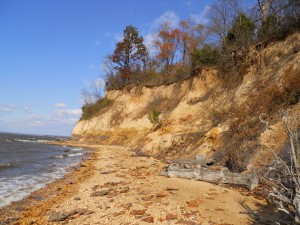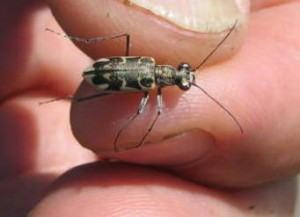Land and a beetle, preserved
 Eastern Shore Land Conservancy this year helped protect more than 170 acres on Girl Scouts of the Chesapeake Bay’s Camp Grove Point in Earleville.
Eastern Shore Land Conservancy this year helped protect more than 170 acres on Girl Scouts of the Chesapeake Bay’s Camp Grove Point in Earleville.
The property’s 2,200 feet of eroding cliffs at the mouth of the Sassafras River provide unique habitat needed by the federally threatened Puritan tiger beetle, a creature smaller than the tip of a fingernail yet a fierce predator in the insect world.
“We are taking a significant step forward in recovering the Puritan tiger beetle, whose largest global population is found in the Chesapeake Bay in Maryland,” said Genevieve LaRouche, Supervisor, U.S. Fish and Wildlife Service Chesapeake Bay Field Office. “This partnership illustrates the important role of local groups and landowners in the conservation of our rare native wildlife.”
Every year, hundreds of Girl Scouts attend day and residential summer camps and participate in troop camping throughout the year.
“Good stewardship of our land is an important part of Girl Scouting,” said Anne T. Hogan, CEO of Girl Scouts of Chesapeake Bay.
“Rich with diverse wetlands and upland forests of oak, tulip poplar, beech and hickory, the new easement will permanently protect the area’s sensitive ecosystem,” said Maryland Department of Natural Resources Secretary Joe Gill. “By preserving this critical landscape we can help guarantee the future of the Puritan tiger beetle, as well as … osprey, eagle, deer, fox and many migratory songbirds.”
Permanent protection of this land will help meet one of the federal criteria required for recovery of this species—to stabilize six large sub-populations and their habitats in the Chesapeake Bay. With the protections on the Girl Scout property, four sub-populations will be protected in Maryland.
 “Preservation of this property not only means protection of a unique ecological site,” said Jared Parks, Eastern Shore Land Conservancy Land Protection Specialist. “It preserves a place where generations of girls can go to explore the outdoors and learn about nature with a great organization devoted to building character and strength.”
“Preservation of this property not only means protection of a unique ecological site,” said Jared Parks, Eastern Shore Land Conservancy Land Protection Specialist. “It preserves a place where generations of girls can go to explore the outdoors and learn about nature with a great organization devoted to building character and strength.”
Development and stabilization projects are the most serious threats to this species. Puritan tiger beetles undergo their entire life cycle on or near cliffs and adjacent sandy beaches, and require some cliff erosion to maintain suitable, unvegetated habitat. Shoreline stabilization minimizes erosion at the base of the bluff, over time making the slopes less steep and allowing vegetation to grow.
This project was made possible through the partnership of ESLC, Girl Scouts of the Chesapeake Bay, Maryland DNR Program Open Space, and USFWS Chesapeake Bay Field Office. Funding was provided through the U.S. Fish and Wildlife Service’s Recovery Grant Program and Maryland’s Program Open Space funds.
Landowners and managers play a vital role in conserving our nation’s wildlife. Most threatened and endangered species depend at least in part on private and other non-federal lands. The Endangered Species Act is not only a critical safety net for America’s native fish, wildlife and plants, but it also provides tools for improved and innovative ways to conserve and recover imperiled species.
Last year, ESLC and Maryland Environmental Trust placed an easement on a nearby Kent County property that also is home to the endangered beetle.






